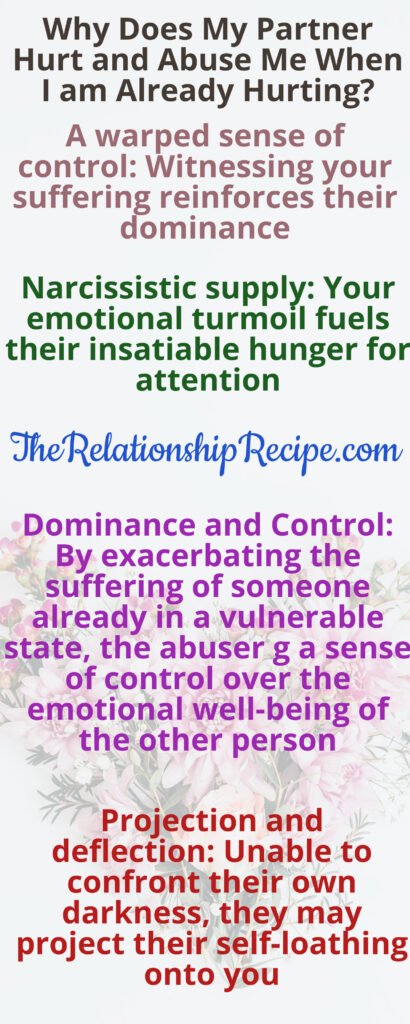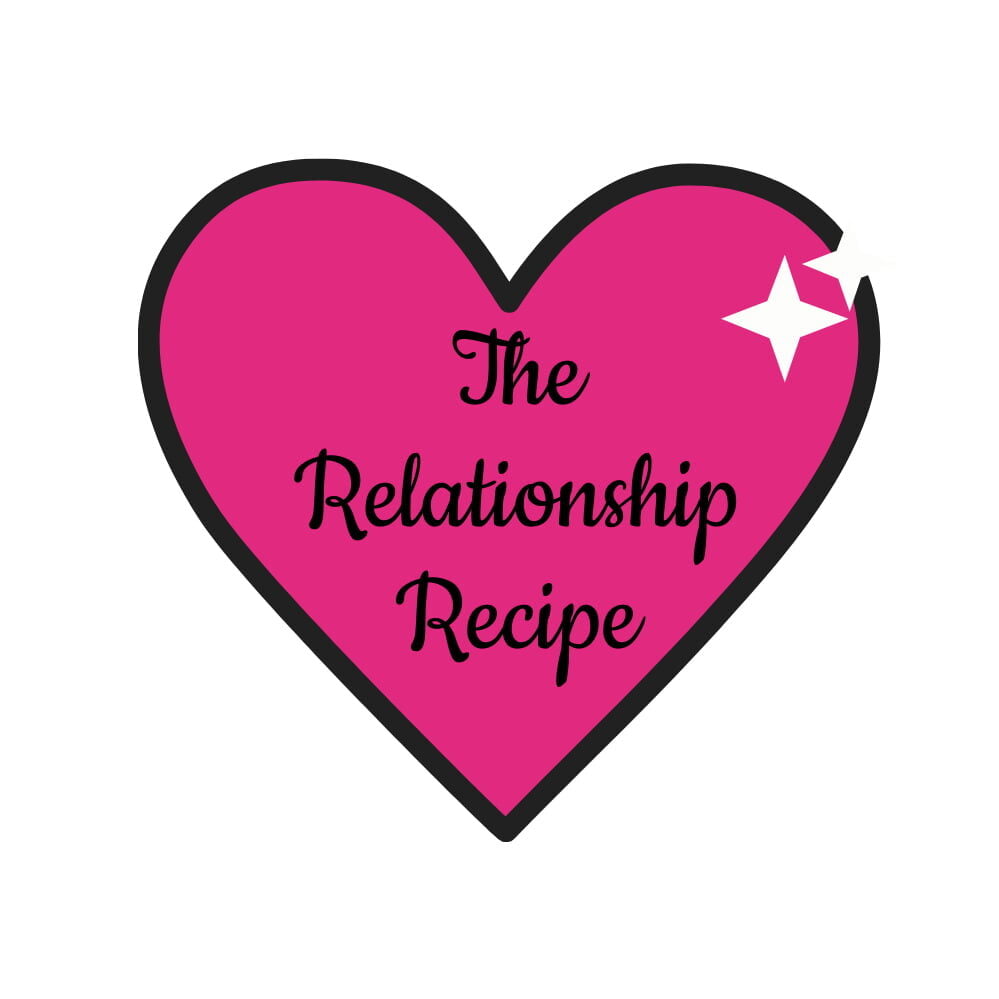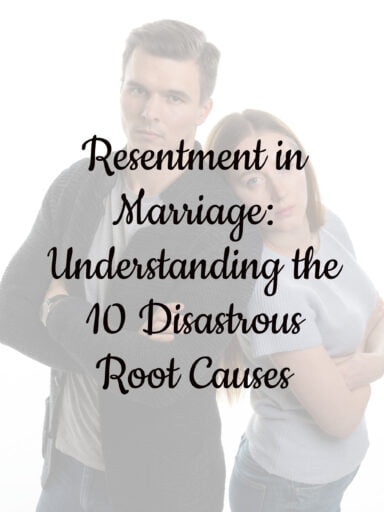Understanding the “Why” of an Abuser Hurting You
The sight of tears reflecting your own shattered heart in their eyes. The way their voice, laced with supposed apology, cuts deeper than any harsh word. You’re hurting, undeniably, and so they see you – vulnerable, broken, as a testament to their power. Yet, the cruelty continues. Why, you ask, when your hurt is laid bare before them, do they persist in twisting the knife?
Is It Normal for my Partner to Love Seeing Me Hurting?
No, it is absolutely not normal for a partner to enjoy seeing you hurt. Healthy relationships are built on empathy and support, not inflicting or reveling in suffering. If your partner thrives on your hurt, it’s a serious red flag indicating potential emotional abuse. Seeking professional help and considering ending the relationship are crucial steps to protect yourself and prioritize your well-being. You deserve someone who cherishes your happiness and lifts you up, not someone who thrives on your hurt.
What Goes Through an Abuser’s Mind When Hurting You?
For many abusers, you’re hurting is not a deterrent, but a perverse reflection of their own twisted desires. They may be propelled by:
A warped sense of control: Witnessing your suffering reinforces their dominance, feeding their insatiable need for power. Your tears are trophies, your anguish a twisted currency in their sadistic game.
A warped sense of control often manifests in the form of emotional manipulation, where individuals may feel the need to exert power over others to compensate for their own insecurities or feelings of vulnerability. When someone continues to inflict hurt upon another person who is already hurting, it can stem from a distorted belief that by causing distress, they can maintain a semblance of control or superiority. This behavior may provide them with a fleeting sense of empowerment, allowing them to divert attention away from their own internal struggles.
Additionally, some individuals may harbor unresolved issues or past traumas that have left them emotionally scarred. Instead of addressing and healing from these wounds, they may unconsciously project their hurt onto others. In doing so, they may create a dynamic where they perceive themselves as the one in control, even if it is at the expense of someone else’s well-being.
Moreover, the continuation of causing harm to someone already in a state of distress may be rooted in a lack of empathy. Those with a warped sense of control may be unable to genuinely understand or connect with the emotional experiences of others. Consequently, they may not recognize the depth of the hurting they are causing or the profound impact it has on the individual already grappling with internal struggles.
In some cases, the individual inflicting harm may be unaware of their actions and their consequences. A lack of self-awareness or an unwillingness to confront one’s own behavior can contribute to a perpetuation of harm without a genuine understanding of its impact.
Understanding the psychological mechanisms behind this behavior is crucial for both the person experiencing the pain and those perpetuating it. Seeking professional support, such as therapy or counseling, can be instrumental in breaking the cycle of harm and fostering healthier patterns of communication and interaction. Ultimately, addressing the root causes of this warped sense of control is essential for promoting personal growth, healing, and fostering healthier relationships.

Narcissistic supply: Your emotional turmoil fuels their insatiable hunger for attention, even negative attention. In their self-absorption, they view your hurting as a twisted form of validation, proof of their impact on your world.
When individuals continue to inflict hurt on someone who is already hurting, especially in the context of narcissistic behavior, the concept of narcissistic supply becomes a pivotal factor. Narcissistic supply refers to the emotional sustenance, admiration, and validation that narcissists incessantly seek from others to maintain their fragile self-esteem and inflated sense of self-worth.
A narcissist’s primary focus is on themselves, and they view relationships as a means to fulfill their insatiable need for attention and affirmation. Witnessing someone in a state of vulnerability or emotional distress might be perceived by a narcissist as an opportunity to secure even more attention, sympathy, or control. They may see the hurting of others as a way to reinforce their own perceived importance and superiority.
In the twisted logic of a narcissist, causing pain to someone already hurting may serve several purposes:
Dominance and Control: By exacerbating the suffering of someone already in a vulnerable state, the narcissist can exert a sense of dominance and control over the emotional well-being of the other person. This manipulation feeds into their desire to be the puppeteer in interpersonal dynamics.
Attention and Pity-Seeking:
- Narcissists thrive on attention, whether positive or negative. By causing pain in someone who is already hurting, they elicit a reaction, garnering the attention and pity they crave. This can provide a temporary boost to their fragile self-esteem.
Deflection from Their Own Issues:
- Inflicting hurt on others may serve as a way for the narcissist to divert attention away from their own insecurities and shortcomings. By focusing on someone else’s suffering, they avoid facing their own internal struggles.
Validation of Superiority:
- Narcissists often perceive themselves as superior and deserving of special treatment. Making others suffer reinforces their distorted belief in their own superiority, as they may interpret the hurt they cause as proof of their dominance.
Lack of Empathy:
- Narcissists, by nature, lack genuine empathy. They may not comprehend or care about the emotional impact of their actions on others. Instead, they prioritize their own desires and needs above anyone else’s well-being.
Understanding the narcissistic supply dynamic is crucial for individuals dealing with such behavior. Establishing boundaries, seeking support from trusted friends or professionals, and, if necessary, distancing oneself from the narcissist can be essential steps toward protecting one’s mental and emotional well-being. Breaking free from the cycle of narcissistic manipulation allows individuals to reclaim their autonomy and focus on healing and personal growth.

Projection and deflection: Unable to confront their own darkness, they may project their self-loathing onto you, turning your hurt into a justification for their actions. By inflicting hurt, they deflect responsibility, painting you as the perpetrator of their own emotional turmoil.
When individuals persistently inflict harm on someone already in a state of distress, the psychological defense mechanisms of projection and deflection often play a significant role. These defense mechanisms serve as tools for those causing harm to avoid confronting their own unresolved issues, insecurities, or emotional pain. Instead of introspecting and addressing their internal struggles, they project their own negative emotions onto the person already experiencing distress.
Projection:
- Projection involves attributing one’s own undesirable thoughts, feelings, or traits to someone else. In the context of causing harm to someone already hurting, the individual inflicting pain may be projecting their own internal turmoil onto the other person. By externalizing their negative emotions, they create a distorted narrative where the source of distress is perceived to be outside themselves.
Deflection:
- Deflection is the act of redirecting attention away from oneself by placing the focus on someone else. In situations where individuals witness another’s vulnerability, they may resort to deflecting attention from their own shortcomings or emotional struggles. Causing additional pain to someone already hurting becomes a means of diverting scrutiny and accountability for their own actions.
Avoidance of Self-Reflection:
- Individuals who engage in projection and deflection may actively avoid self-reflection and introspection. Acknowledging their own issues can be challenging and uncomfortable, so they choose to transfer the emotional burden onto someone else, perpetuating a cycle of harm without addressing the root causes.
Maintaining a Facade:
- Projection and deflection enable individuals to maintain a façade of strength or superiority. By focusing on the perceived flaws or weaknesses of others, they create a smokescreen that conceals their own vulnerabilities. This façade serves as a defense mechanism to shield themselves from exposure and potential criticism.
Control and Power Dynamics:
- For some, causing pain to someone already hurting may provide a false sense of control. By projecting their own unresolved issues, they assert dominance and manipulate the power dynamics within the relationship. This control becomes a way to mask their own feelings of inadequacy.
Breaking free from the cycle of projection and deflection requires a combination of self-awareness and setting firm boundaries. Recognizing these defense mechanisms allows individuals to understand that the pain inflicted upon them is not a reflection of their worth but rather a manifestation of the other person’s internal struggles. Seeking support from friends, family, or mental health professionals can be instrumental in navigating these complex dynamics and fostering personal healing and growth.
Breaking the Cycle: Red Flags to Look For
Understanding the “why” of an abuser’s cruelty is only the first step. Recognizing the red flags is crucial:
The Jekyll and Hyde behavior: Periods of charm punctuated by unexpected episodes of cruelty create a confusing cycle of hope and despair.
During the charming phases, individuals often experience a sense of hope and connection, drawn to the seemingly kind and affable persona displayed by the individual. However, this hope is shattered when it unexpectedly transforms into cruelty, leaving those on the receiving end bewildered and emotionally wounded.
The abrupt shifts between these two contrasting personalities contribute to a profound sense of despair and confusion. The unpredictability of the Jekyll and Hyde dynamic makes it challenging for individuals to anticipate the behavior of the person involved, fostering an environment of emotional instability and eroding trust.
This cycle can be emotionally draining and detrimental to one’s mental well-being, highlighting the importance of recognizing and addressing such patterns in relationships for the sake of personal health and resilience.
Gaslighting and manipulation: Twisting reality, denying their actions, and making you question your own sanity are hallmarks of an abuser’s toolkit. Gaslighting and manipulation form insidious elements within the arsenal of an abuser, creating a toxic environment characterized by the distortion of reality and the erosion of an individual’s self-perception.
This emotionally abusive tactic involves the deliberate twisting of facts, denial of harmful actions, and subtle maneuvers aimed at making the victim question their own sanity and perceptions. Gaslighting is a form of psychological warfare wherein the abuser cunningly undermines the victim’s confidence in their own experiences, memory, and judgment.
By sowing seeds of doubt and confusion, the manipulator gains a sinister sense of control, leaving the victim grappling with a distorted version of reality. Over time, the cumulative impact of gaslighting can result in a profound sense of self-doubt and a skewed understanding of the truth, making it imperative for individuals to recognize these tactics and seek support to reclaim their sense of reality and mental well-being.
Isolation and control: Severing your connections with loved ones and restricting your freedoms further tighten their grip on your reality. Isolation and control, as wielded by manipulative individuals, represent a potent strategy to tighten their grip on your reality and reinforce their dominance.
By systematically severing connections with loved ones, be it friends or family, the manipulator creates an environment where their influence becomes paramount. This isolation not only diminishes your support network but also intensifies reliance on the manipulator for emotional and social needs.
Concurrently, the exertion of control extends to restricting your freedoms and autonomy. Whether through overt rules or subtle coercion, the abuser seeks to limit your ability to make independent choices, thereby consolidating their dominance.
The combination of isolation and control forms a formidable mechanism, fostering dependency and making it imperative to recognize these tactics early on to break free from the shackles of manipulation and reclaim agency over one’s life. Seeking support from trusted individuals and establishing strong boundaries are crucial steps in dismantling this toxic dynamic.
If you see these reflections in your own relationship, remember:
- You are not alone: Numerous resources and support groups stand ready to guide you through this journey.
- Safety first: If you feel immediate danger, reach out to emergency services or trusted individuals without delay.
- No contact is key: Breaking the cycle may be difficult, but establishing and maintaining no contact is vital for your emotional and physical well-being.
When You Have to Leave
Leaving an abusive relationship requires immense courage. Here are some resources to empower your journey:
- The National Domestic Violence Hotline: 1-800-799-SAFE (7233)
- The National Network to End Domestic Violence: https://nnedv.org/
- The National Coalition Against Domestic Violence: https://ncadv.org/
- The National Women’s Law Center: https://nwlc.org/
Remember, seeking help is not a sign of weakness, but an act of immense strength. These resources offer legal support, emergency shelters, support groups, and counseling services – a hand to hold you as you walk towards a brighter future.
Finally, beyond understanding the abuser’s motives, focus on healing your own wounds. Reconnect with loved ones, seek professional help, and rediscover your inner strength. The road to recovery may be long, but with each step, the shadows of the past fade, replaced by the light of a future reclaimed.
This journey is yours alone, but you are not walking it in the dark. Take heart, reach out, and reclaim your life. You are more than the sum of your pain, and a world of healing awaits you beyond the veil of tears.
Please note: This post is for informational purposes only and does not constitute professional advice. If you are in an abusive relationship, please seek professional help and prioritize your safety.

This post may contain affiliate links. I earn from qualifying Amazon purchases at no extra cost to you.




